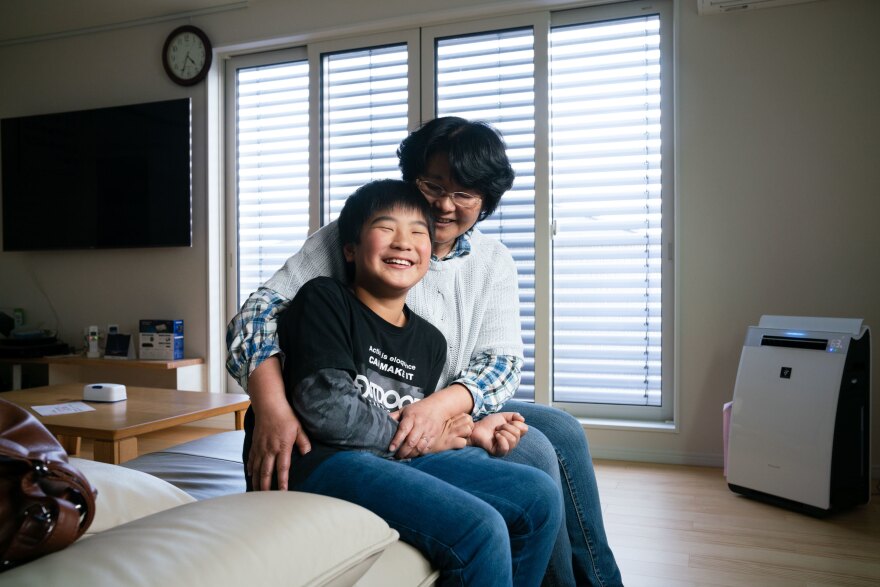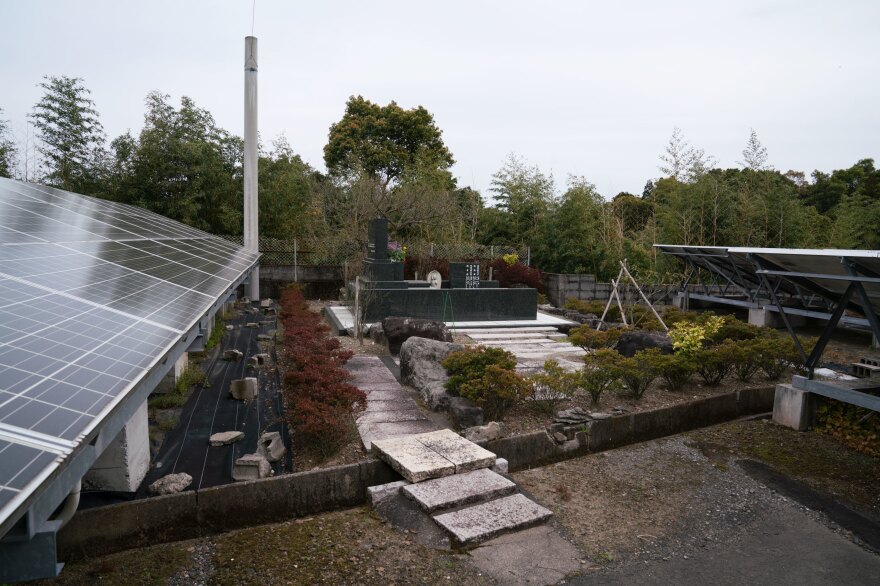Atop a small hill on the southern Japanese island of Kyushu sits a small solar farm with big, broad panels lined up in rows, tilting to catch the sun. Lush vegetation creeps over the edges of the surrounding fence. In the center of the panels, there's a tall marble gravestone, with an inscription in Japanese.
"Remember that this family evacuated Futaba town, Fukushima prefecture," it reads, "and moved here due to the nuclear accident following the Great East Japan Earthquake that occurred on March 11, 2011."
The grave belongs to Hiroyuki Endo, a supervisor and maintenance worker at the Fukushima Daiichi Nuclear Power Plant. He fled Fukushima with his family after the disaster and settled nearly 1,000 miles away, as far south as they could drive. He and his family decided to build this solar farm for a living. When Hiroyuki suddenly died four years ago of a brain aneurysm, his wife, Chiyomi Endo, took over.
Earlier this spring, Endo, 48, stood by Hiroyuki's grave, looking out at the solar panels. "Ten years ago, I never thought I'd be doing this," she said with a laugh. "Life is very different now."
The Endos were part of a wave of enthusiasm for renewable energy that followed Japan's Fukushima nuclear disaster, in which a massive earthquake and tsunami damaged the Daiichi plant. Nuclear power, which once produced nearly a third of Japan's energy, ground to a halt when all 54 of the country's nuclear reactors were taken offline as new safety regulations were imposed. The Japanese government offered huge incentives for renewable energy production, looking to fill the gap.

But in the years since, those incentives have dwindled and the commitment to energy transformation has slowed. With most of the country's nuclear reactors still unproductive, Japan has instead pivoted to a different kind of transformation — increasing its dependence on fossil fuels.
"An investment for the future generation"
Endo says she and her husband started their small solar farm out of necessity after the disaster. They were in a new place and had left everything behind.
"We were trying to figure out — 'OK, do we get new jobs here?' So we decided to try something new," she said, gesturing to the panels. "We saw it as an investment for the future generation. We want to pass it on to our children."

But her husband, who worked at Daiichi for over two decades, also felt betrayed by the industry.
"He thought it was safe," she remembered. "And then when the reactors exploded, he gave it all up. He said, 'That's the end, it's over.' And we left."
Their old home, in the exclusion zone in the town of Futaba near the Daiichi plant, has sat practically untouched for nine years. It's unclear when — or if — the area will be livable again.
Earlier this year, Endo went to say one final goodbye and handed over the keys to government officials. The house, still full of their old furniture and belongings, is slated to be bulldozed, and the land will be used as part of a storage site for millions of bags of radioactive topsoil collected during cleanup of the contaminated area.

Now, Endo and her 10-year-old son, Keiji, live in a bright, sunny new house near their solar farm in the city of Kagoshima. Her two other children, now grown, live nearby. Keiji is bright and bubbly, cracking jokes and handing out origami animals to visitors. He was only a year old when the disaster happened and doesn't remember Fukushima — or life near a nuclear power plant — at all.
"My biggest wish is for renewable energy to take over," Endo said. "Look at my old home. It's going to be a storage site for nuclear waste. We can't deal with that kind of waste forever."

"Almost anyone could register"
Endo's wish may not come true. Her family entered the renewable energy business at just the right time, when every nuclear reactor in Japan was taken offline. To encourage new investment, the government passed a law requiring utility companies to pay renewable energy producers high compensation, known as feed-in tariffs.
In the years immediately after the 2011 disaster, "The price was so generous and the regulations were so loose — almost anyone could register," said Tetsunari Iida, executive director of the Institute for Sustainable Energy Policies in Tokyo.
Some, like Chiyomi and her husband, jumped in to build smaller, local operations, while corporations rushed to build massive solar and wind farms. Renewable energy production in Japan — particularly solar — increased year after year, nearly doubling in the nine years since the Fukushima nuclear disaster.
But in 2018, the Japanese government began backpedaling on the feed-in tariffs, announcing that it would reduce them by more than half, as utility companies passed the cost onto consumers and energy bills skyrocketed.
And, Iida points out, it has become increasingly difficult for renewables to connect into the power grid.
"The big electricity monopolies have set up a kind of barrier to stop the rapid increase of renewables," said Iida. He notes that the utilities often favor their own power plants, which burn imported coal or natural gas. With few homegrown energy sources other than its previous production of nuclear power, Japan is one of the world's top importers of both coal and natural gas. Prior to the Fukushima disaster, Japan had planned to reduce its dependence on coal by more than half in the coming decade; it has instead increased.

After initially prioritizing renewables in response to the disaster, a change in government rules in 2015 gave Japan's utility companies greater flexibility to shut out alternative energy producers.
"The institutions make a big difference," said Jennifer Sklarew, an assistant professor at George Mason University in Virginia who studies energy policy in Japan and previously served as a consultant to Japanese utility companies. "If the people in place do not want to implement policies to empower the economics and the technology innovation, then it can't happen — regardless of how good those technologies are or how good the economics look."
Fossil fuels front and center — except in Fukushima
Japan's reliance on fossil fuels after the Fukushima disaster has worried climate groups, which say the country is not doing nearly enough to curb greenhouse gas emissions, a major driver of global warming. Scientists say the world needs to essentially eliminate new carbon emissions by 2050 to avoid the most catastrophic impacts of climate change.
Nuclear reactors do not directly produce carbon dioxide, and even after the disaster, Prime Minister Shinzo Abe's party began pushing to restart them, arguing that it would be the best way for Japan to combat climate change while having a stable, homegrown energy source. So far, nine of Japan's 54 nuclear reactors have restarted, but many more are slated for decommissioning as the cost of upgrading them with new safety regulations implemented after 2011 becomes too great.
In the meantime, Japan is rolling out major new coal operations, in stark contrast with other developed countries. Critics say the country is headed in the wrong direction, keeping fossil fuels — which currently account for more than two-thirds of Japan's energy supply — front and center for now.

"It's the most realistic, and not so optimistic, future," Iida said.
Fukushima, though, is one place that has been significantly picking up the slack where renewable energy is concerned.
The local government set a goal for the entire prefecture — Japan's third-largest — to be completely fueled by renewable energy by 2040.
Solar panels are ubiquitous, especially in the area around Daiichi that was evacuated after the disaster. They line hillsides and gleam on rooftops of individual houses. Megafarms stretch for miles along highways.
Out in the farmland of Iitate, a community once known for producing rice and beef, solar panels now sprout from fields instead of crops.
"This is all my land — but it's nonsense now," said 74-year-old farmer Shigeyuki Konno with a laugh. He pointed to the land around his one-story home, where his family has been growing tobacco, rice and buckwheat for generations.
He calls his land "nonsense" because it's relatively useless now. The wind carried high amounts of radioactive material here after the disaster, and the government scraped off all the topsoil in decontamination efforts. The farmers here can't really farm much anymore.

So when a local power company came and asked Konno whether it could rent his land to install solar panels, he said yes — and most of his neighbors did, too.
But, Konno pointed out, this area is so different now. There used to be rice paddies all around, filled with water and tiny frogs that created a kind of soundtrack for his life. Now it's quiet.
"I miss the frogs a lot," he said with a sigh.
Konno doesn't earn nearly as much now as he did farming, but he sees this as a necessary change. He has nine grandchildren, who all live far away now, scattered after the disaster. They were in town for a visit on a recent weekend, running through the fields.
"My grandparents were farming here, my parents, too. But now, we have to change," Konno said. "We're entering the time for solar energy, so I've realized it's a new season. This is for future generations."
Kat Lonsdorf (@lilkat_bigworld) is NPR's Above the Fray fellow. The fellowship is sponsored by the John Alexander Project, which supports foreign reporting in undercovered parts of the world. Follow the fellowship on Instagram (@thejohnaproject) and Twitter (@thejohnaproject)
Copyright 2023 NPR. To see more, visit https://www.npr.org.


